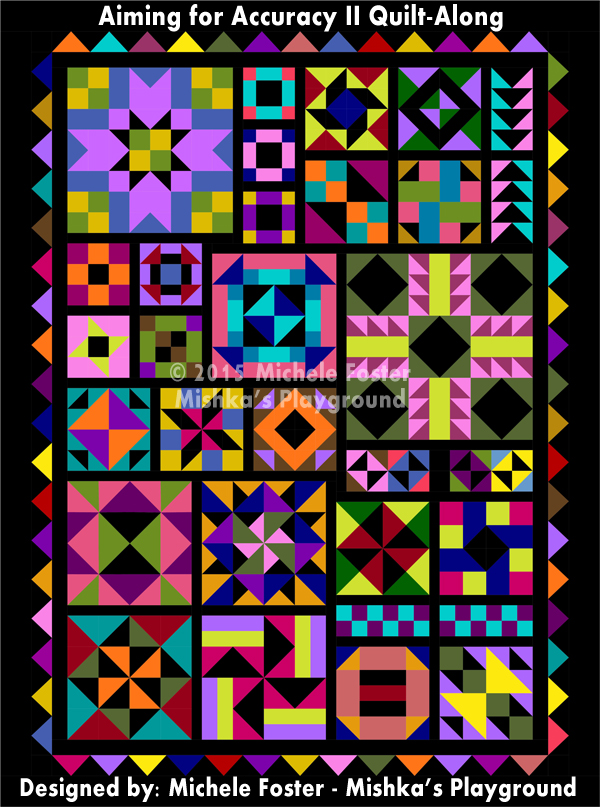
Designed by: Michele Foster
Pattern code: A4A-119
Finished size: 58″ x 78″
Skill level: Confident Beginner
Technique: Piecing
Format: PDF file [99 pages]
Don’t let this unique puzzle-like design scare you. In this Skill Building Booklet, I walk you through, step-by-step, with full colour diagrams, how to complete this quilt top. You’ll start off with piecing some of the easier blocks and progress, in a logical manner, through to the more advanced blocks.
Each block in the quilt has been chosen for it’s learning potential. Blocks range both in size and complexity. Once you complete all lessons, you’ll be confident in your ability to make half-square, quarter-square and split-quarter-square triangles, as well as, square-in-a-square and flying geese units.
Quick facts about the quilt:
- Twenty-six (26) unique blocks are used in the quilt top forming the puzzle-like design.
- Finished block sizes range from 4″ to 18″.
- Finished quilt size is 58″ x 78″
Below are some of the things that you will learn:
- Two different methods for making half-square, quarter-square and split-quarter-square triangles, as well as square-in-a-square and flying geese units.
- What does a scant 1/4″ really mean, and why is it important?
- How pins really are a quilters’ best friend and how to take advantage of fabric ease.
- The importance of pre-washing your fabric and using spray starch and/or magic sizing.
- Proper techniques for pressing quilt blocks and tips on when it’s a good idea to press seams open versus to one side.
- How to avoid chopping off your triangle points when attaching sashing and joining blocks.
- How to dissect a quilt block to determine the grid used to create it. Once you know the grid size, you can easily make blocks larger or smaller and adjust any pattern to fit your own piecing preferences.
- Why you should never trim your completed quilt blocks… it’s all about piecing accuracy.
You should already know:
- Standard quilting terminology, such as fat quarter, sashing, batting, selvedge, etc.
- How to use your sewing machine, make adjustments to stitch width, length and tension, if needed.
- How to cut fabrics using a rotary cutter and ruler. I cover some tips, but you should know the basics.
I encourage you to join our Facebook Group where you’ll have the opportunity to chat and share photos with others making this quilt.
Fabric Requirements
The fabric requirements presented below are generous. I plan to use leftover fabrics from the front when piecing the quilt backing. Please read the additional notes below carefully.
- 4 to 5 yards of assorted prints
- 3.5 yards of contrasting fabric
- 1/2 yard for binding (with a 2.5″ cut width)
- 3.5 yards for backing
- 64″ x 84″ batting (allows for 3″ extra on each side)
Assorted prints: The 4 to 5 yards represents 18-24 fat quarters which will give you a good variety of prints to use. You will have some leftovers, but they can be used for the quilt back. You should be able to get by with only 18 fat quarters, but you’ll want to be extra careful when cutting. Alternatively, if you wish to use four fabrics (plus contrast), as shown in a couple of the alternative colour-ways below, you will need 1 yard of each of the four. You might wish to purchase 1.25 yards of each to be on the safe side.
The contrasting fabric is represented by black in the large quilt version above. You can use any colour you like, just be sure that it contrasts well with your chosen assorted prints. You need a good contrasting fabric so that the design stands out.
Optional: Depending on your own level of expertise, you might wish to have 1 yard of additional fabrics that you can use for creating sample pieces. Scraps will be fine.
Tools & Products
Below is a list of the standard quilting-making tools you should have:
- Sewing machine in good working order.
- 1/4″ foot for your machine, or if you don’t have a specific foot, the ability to create an accurate 1/4″ seam allowance.
- Cutting mat.
- Rotary cutter with a new blade. You’ll get the most use out of a 45mm rotary cutter.
- Various cutting rulers, such as a 6.5″ square, a 12.5″ square (optional), a 6.5″ x 24.5″ (or 12.5″). Whatever rulers you currently have and are comfortable using, will be fine.
- Good quality piecing thread, such as Aurifil 50wt cotton.
You can purchase a starter kit here that includes a rotary mat, cutter, ruler and Clover piecing pins.
Colour Variations
Shown below are some different colour ways to inspire you when choosing which fabrics you would like to use for this quilt. The fabric options are endless for this quilt. Just be sure that you have a strong background, that contrasts well with your other fabrics, and it’ll turn out great.

Buy Now!
This quilt design, tutorial and photos are copyright Michele Foster of Aiming for Accuracy Pattern Co. Please respect copyright and do not copy the tutorial or republish it, for free or for sale, in print or online. You may use this tutorial for your own personal use to create products for free or for sale. However, please credit Michele Foster of Aiming for Accuracy Pattern Co. for the design. No mass production is allowed.
